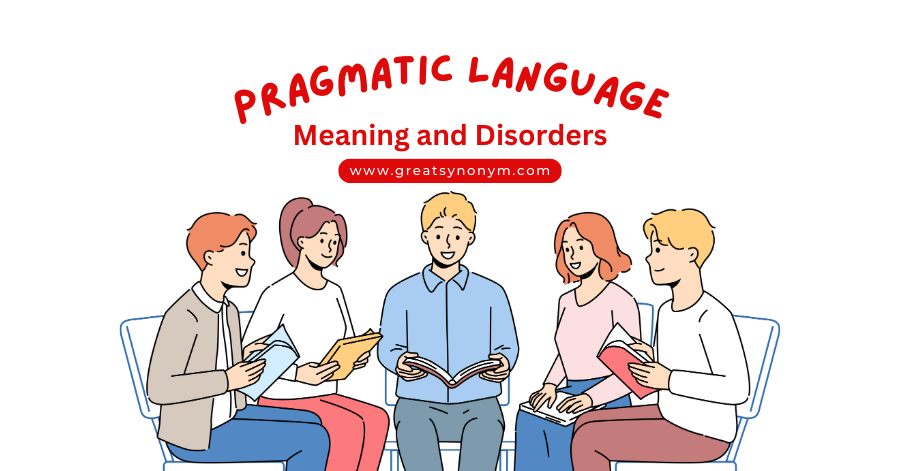Hello viewers! Great Synonym welcomes you back to another informative and interesting blog post topic. Today’s blog post is about pragmatic language. Have you ever thought about what are the main factors that can majorly affect our social communications, interactions, and meetups? No doubt, a great use of language would help. But it only helps in passing the exact information or pieces of words. This is what most people think communication is. Pragmatic language is far more than simple communication. Read the blog post till the end to get a better understanding.
Pragmatic Language:
Pragmatic language refers to the process of communication where actions play a significant role alongside words to convey the genre of communication. These actions further carry information about the context, intent, emotions, voice tones, body language, and behaviors. According to a survey, seventy percent of effective communication results from the use of these actions.
Example:
Imagine you’re chilling at your home playing video games in the summer holidays. The Air Conditioner has maintained the temperature of your room at an enjoyable level. Now you want to enjoy an ice cream in this lovely environment. All you have to do is leave your room and go to the kitchen fridge where your ice cream is placed. You raise a voice and ask your mother, “Would you please pass me a scope of vanilla and caramel ice cream?”
But you notice that your mother is busy washing dishes. So, now are you gonna use pragmatic language to convey your request more effectively. You could say, “Hey Mom! I see you’re busy with the dishes. When you get a chance, could you please pass me a scoop of vanilla and caramel ice cream?” By acknowledging her current task and politely asking for the ice cream when she has a moment, you’re using pragmatic language to communicate effectively. By formally acknowledging her ongoing activity and politely requesting the ice cream at her convenience, you are using pragmatic language to successfully convey your message.
Pragmatics and Language:
Both pragmatics and language are related terms. The primary goal of the language is to facilitate understanding between people. So, it is not wrong to say that language serves as a means of communication. It is just a communication tool. While pragmatics refers to the context or intent of your communication. Pragmatics add emotions and feelings to our words. It is independent of syntax and semantics. Combining both terms pragmatics and language can lead to the enhancement of communication by considering not only the words used but also the context, intentions, emotions, and cultural factors involved in the interaction.
Syntax:
In the English language, letters make words and these words make sentences or phrases. We name this whole procedure as the structure of the language. This structure is called the Syntax.
Semantics:
Sometimes, we don’t know the exact meaning of the word. By listening or reading the sentence as a whole, we guess what this word means. It is the context of the sentence that helps us guess the meaning. So, we can say that semantics helps us understand the meanings of the sentence or phrase.
Emojis as Pragmatic Tools in Messaging:
Do you know that the emojis we mostly use in our chats are another form of pragmatic communication? By using emojis, senders can enhance the receiver’s understanding of the message. As, emojis convey emotions, tone, and intentions that may not be fully captured through text alone.
Written messages express comparable feelings, intentions, and context, creating a sense of physical communication with the recipient. Also, emojis are the best way to express your feelings and emotions along with words.
😊 : Indicates happiness or friendliness.
👍 : Signifies agreement or approval.
❤️ : Represents love or affection.
😂 : Conveys laughter or amusement.
Example:
Imagine it’s almost midnight. You are feeling lonely, laying on your bed watching an alone shiny start from your window and remembering your favorite person. This time, you received a message from that person you were missing, desperately! And the message is, “How are you?” A simple reply would be, “I’m fine.” But with the help of emojis, you can reply in different ways as:
- “I’m fine. 😊”: This means that you are really fine and happy.
- “I’m fine. 😡”: This means that you might be mad at something or upset.
- “I’m fine. 😑”: This means you are not interested or excited about it.
- “I’m fine. 😢”: This signals that you might be sad or unwell.
- “I’m fine. 😏”: This could mean you’re being humorous or not being honest.
By using emojis in writing, people can make their words clearer and more expressive. Also, it encourages pragmatic language use, which is especially important in online contexts where spoken words are limited.
Pragmatic Language Disorders:
Some disorders can happen to people who have trouble with pragmatic speaking. People with these disorders are called pragmatic language disorders or social communication disorders. They may have trouble using social language in several ways. Also, It can be hard to understand and use body language, movements, and tone of voice for them. They may struggle to start and maintain conversations and have trouble taking turns, and staying on topic. Sometimes, they might speak too loudly, too softly, or inappropriately for the situation.”
Conclusion:
This is all of our blog post on pragmatic language. Understanding pragmatic language goes beyond mere communication. Because it includes actions as well as words and effectively communicates context, purpose, and feelings. Emojis are useful tools that make texting better by letting people show how they feel and what they want to say.
However, some people may have trouble with pragmatic language, which can make it hard for them to connect with others. By acknowledging and resolving these problems, we can make both written and verbal interaction more conversational and enjoyable for everyone. I hope all of you have enjoyed reading the blog post.


